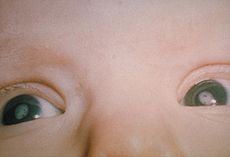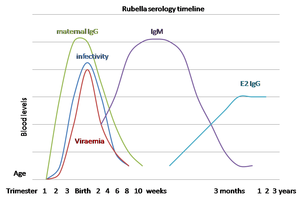- Congenital rubella syndrome
-
Congenital rubella syndrome Classification and external resources 
Congenital Cataracts (white pupils) due to congenital rubella syndromeICD-10 P35.0 ICD-9 771.0 DiseasesDB 11729 MedlinePlus 001658 eMedicine emerg/388 MeSH D012410 Congenital rubella syndrome (CRS) can occur in a developing fetus of a pregnant woman who has contracted rubella during her first trimester. If infection occurs 0–28 days before conception, there is a 43% chance the infant will be affected. If the infection occurs 0–12 weeks after conception, there is a 51% chance the infant will be affected. If the infection occurs 13–26 weeks after conception there is a 23% chance the infant will be affected by the disease. Infants are not generally affected if rubella is contracted during the third trimester, or 26–40 weeks after conception. Problems rarely occur when rubella is contracted by the mother after 20 weeks of gestation and continues to disseminate the virus after birth.
It was discovered in 1941 by Australian Norman McAllister Gregg.
Contents
Presentation
The classic triad for congenital rubella syndrome is:
- Sensorineural deafness (58% of patients)
- Eye abnormalities—especially retinopathy, cataract and microphthalmia (43% of patients)
- Congenital heart disease—especially patent ductus arteriosus (50% of patients)
Other manifestations of CRS may include:
- Spleen, liver or bone marrow problems (some of which may disappear shortly after birth)
- Mental retardation
- Small head size (microcephaly)
- Eye defects
- Low birth weight
- Thrombocytopenic purpura (presents as a characteristic blueberry muffin rash)
- Hepatomegaly
- Micrognathia
Children who have been exposed to rubella in the womb should also be watched closely as they age for any indication of the following:
- Developmental delay
- Autism spectrum disorders[1]
- Schizophrenia[2]
- Growth retardation
- Learning disabilities
- Diabetes
- Glaucoma
Prevention
Vaccination of girls of childbearing age against rubella can prevent congenital rubella syndrome.
References
External links
Infectious skin disease: Viral cutaneous conditions, including viral exanthema (B00–B09, 050–059) Ungrouped unknown/multiple: Asymmetric periflexural exanthem of childhood · Post-vaccination follicular eruption · Lipschütz ulcer · Eruptive pseudoangiomatosis · Viral-associated trichodysplasia · Gianotti–Crosti syndromeCertain conditions originating in the perinatal period / fetal disease (P, 760–779) Maternal factors and
complications of pregnancy,
labour and deliveryLength of gestation
and fetal growthSmall for gestational age/Large for gestational age · Preterm birth/Postmature birth · Intrauterine growth restrictionBirth trauma By system Vitamin K deficiency (Haemorrhagic disease of the newborn)HDN (ABO • Anti-Kell • Rh c • Rh D • Rh E) · Hydrops fetalis · Hyperbilirubinemia (Kernicterus, Neonatal jaundice)Integument and
temperature regulationErythema toxicum · Sclerema neonatorumInfectious Perinatal infection (Congenital rubella syndrome, Neonatal herpes simplex) · Omphalitis · Neonatal sepsis (Group B streptococcal infection) · Neonatal conjunctivitisOther Diseases of maternal transmission / perinatal infection / vertical transmission (P35–P39, 771) Gestational/
transplacental/TORCH complexvirus (Congenital rubella syndrome, Congenital cytomegalovirus infection, Neonatal herpes simplex) · Hepatitis B · Congenital varicella syndrome · HIV · Fifth diseasebacteria (Congenital syphilis)other (Toxoplasmosis)Transmissible at birth/
transcervicalCell-mediated immunodeficiency
of late pregnancyBreastfeeding Categories:- Congenital disorders
- Syndromes
- Virus-related cutaneous conditions
- Infections specific to the perinatal period
- Rubella
Wikimedia Foundation. 2010.


